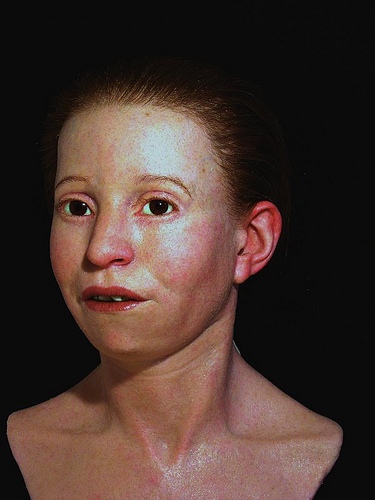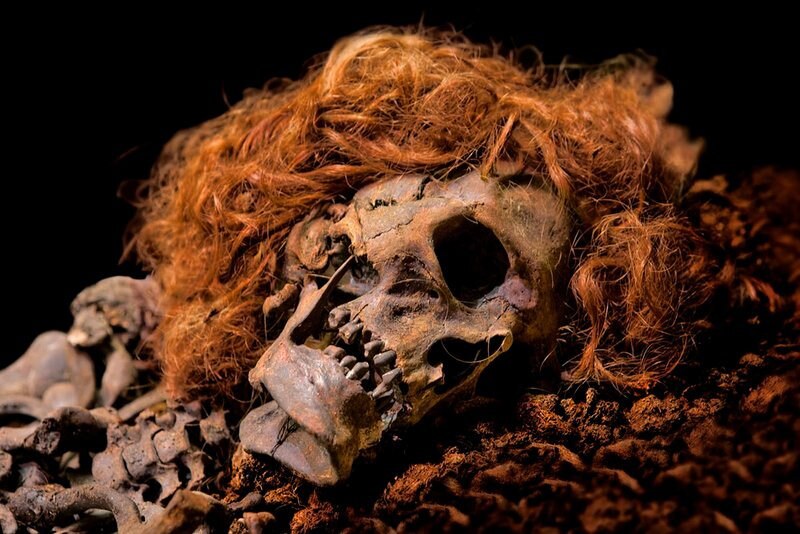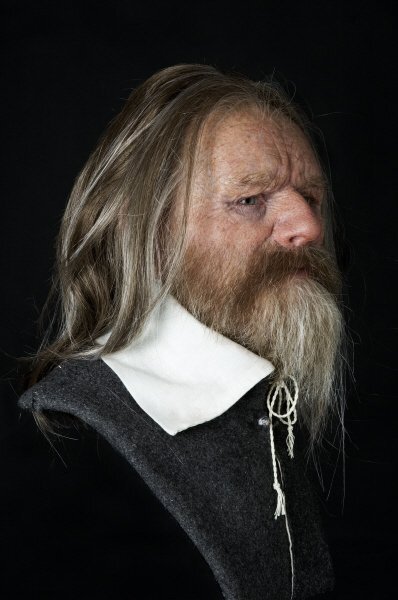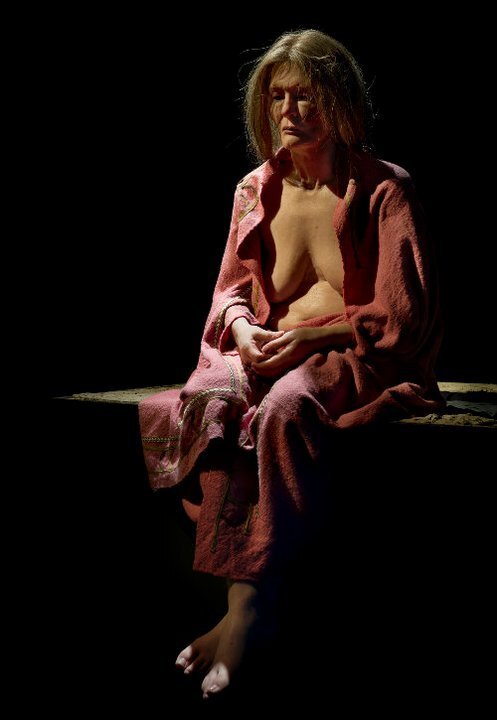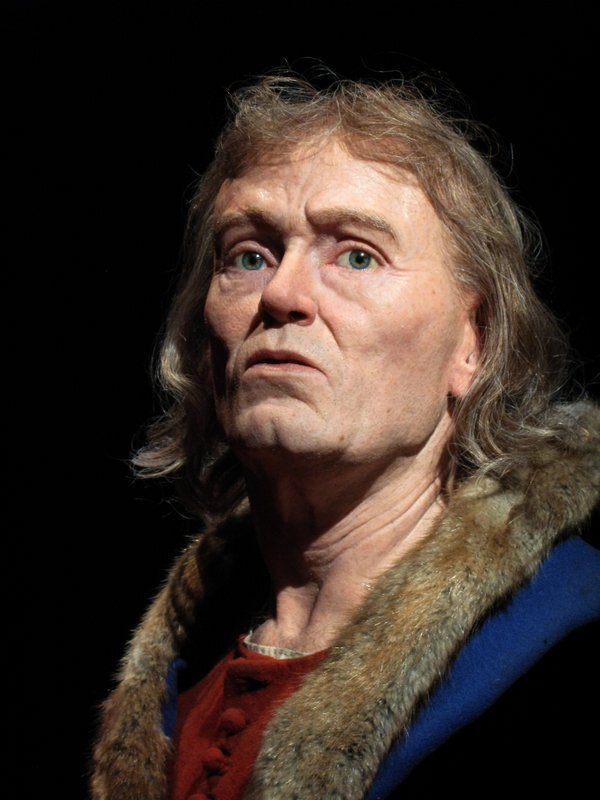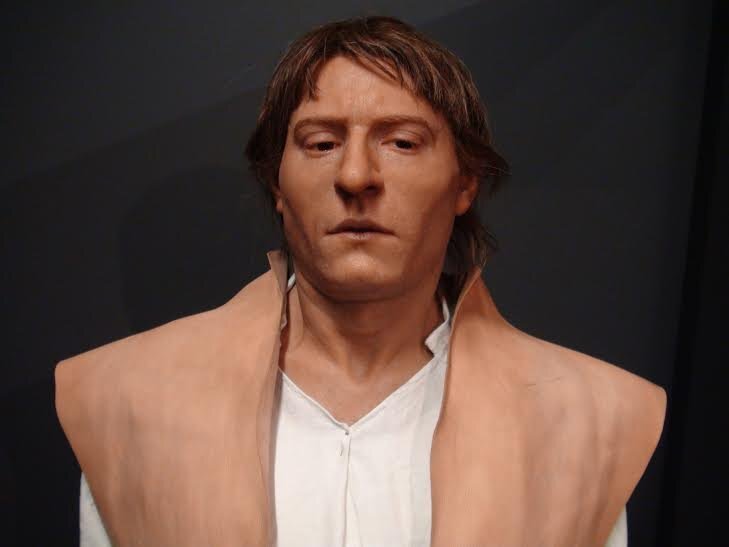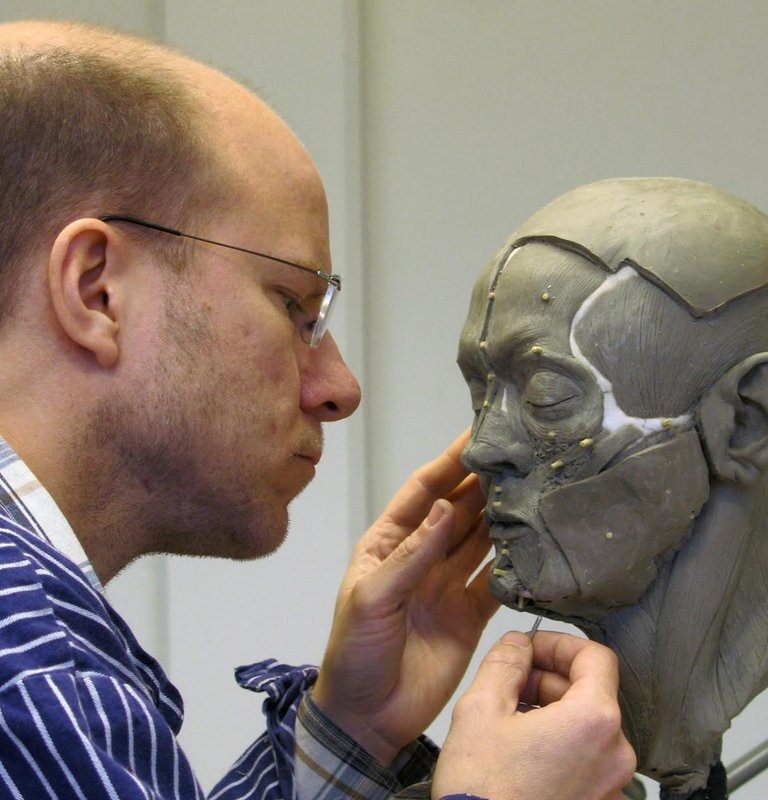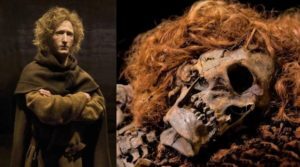
On any given day, you might see Oscar Nilsson busily engaged on a project in his new workspace in Tumba, just south of Stockholm, Sweden. A green and pleasant suburban extension of Stockholm, Tumba is a community consisting of families and workers connected to the town’s papermill and milk processing industries, though many commute into the city for their livelihoods, much like any other suburban community.
But Nilsson is unlike most other Tumba residents. He is a sculptor, though not of the usual variety. He works in a well-lighted 80-square-meter newly converted art gallery space. Now a studio, its bookshelves are filled with literature on facial reconstruction, anatomy, anthropology, history, art……….and 30 plastic replicas of human skulls. One can see a vacuum machine for castings, a lightboard, airbrush tools, brushes, and other tools of his trade, including a smaller room for castings and mold-making. He spends much of his time at two ergonomic worktables.
Oscar Nilsson has a passion for reconstructing the past, or, more specifically, human faces of the past. He can do this because he is not only an artist, but also an archaeologist by education, armed with a knowledge of human anatomy, a familiarity with osteology (the scientific study of bones], and a finely honed set of skills for handling specialized materials to create lifelike, hyper-realistic facial reconstructions of individuals who came and went long before us, before the advent of photography.
For Nilsson the archaeologist, the artifacts and monumental remains that the archaeologist unearths in the field and interprets and reports about in the scholarly journals are important. They illuminate our understanding of our collective past.
“But history is made of actual people,” he is quick to add.
And this is where he lights up. “Making a facial reconstruction is like opening a window to the past, an opportunity to see what the people from history really looked like,” he told Popular Archaeology. “So the face tells a direct story to the beholder, establishing an emotional and personal connection that text or written records can never accomplish.”
Looking at his creations, one can see precisely what he means. A medieval face stares defiantly back at you and you can hear the face’s owner say in your mind’s ear, “I have been ill-treated.” Or a 13th century Swedish ruler, whose face shows not only his past-prime age but the contemplative facial expression of a man weighed by the momentary task of making an important decision, says “give me pause to think.” So life-like are the reconstructions, one could almost ask of these long-dead people: “Have we met before?” Archaeology, history, osteological analysis, state-of-the-art technology, and the skill of a seasoned artist and other artisans—all have combined to inform the creation.
His finished subjects have ranged from a 5500-year-old Stone Age man whose remains were unearthed near Stonehenge in the U.K., to a young Greek girl who died in Athens around 430 B.C., to six drowned victims of a salvaged 17th century warship. With 50 subjects completed thus far, his works grace the exhibit halls of museums around the world. “My ambition is to get the museum visitor as close to the people of the past as possible,” he says. And like any artist, he has some personal favorites:
In the Museums
Located on the island of Djurgården in Stockholm, Sweden, the Vasa Museum houses the only nearly completely intact 17th century ship that has ever been salvaged, the warship Vasa, which sank on her maiden voyage in 1628. It draws visitors from around the world, making this Scandinavia’s most visited museum attraction—and for good reason. Remarkably preserved in striking detail, it appears almost as if it were built only decades ago. Equally remarkable, however, is the adjacent exhibit of six hyper-realistic facial reconstructions derived from the excavated skeletal remains of drowned seamen who vanquished with the ship. They represent the results of one of Nilsson’s favorite projects. “To reconstruct six faces of the drowned victims from the Vasa ship was a very special project,” Nilsson told Popular Archaeology. He mentioned several other projects in the same vain, the reconstructions of which are found in other museums, such as 9 faces of seamen connected to the Mary Rose—the flagship of renaissance England’s King Henry VIII—a Stone Age man from Stonehenge, and the “Bocksten Man”.
The Bocksten Man reconstruction strikes a particularly strong chord with Nilsson for a number of reasons. The remains of this individual, discovered and excavated from a bog about 15 miles east of Varburg on the west coast of Sweden, is among Sweden’s most famous medieval ‘cold cases’, evidencing a violent death. His clothing and other accoutrements were found in remarkably well-preserved condition. As Nilsson describes:
“Before the reconstruction was made his skeleton, including hair and skin tissues, were on display in the museum in Varberg. This has made a lasting memory for generations of school children who visited the museum. He became ”the phantom”, a frightening image of a violent death. But once my reconstruction was completed and displayed, something happened; he became a human instead of a freak. He regained some of his dignity here.
But the story itself is incredibly intriguing. This man, who died around 1370, may have been impaled. This has been interpreted as an attempt by the medieval community of the time to prevent the man from rising from the scene of his death as a ghost and haunting his killers and the neighborhood.
Who was he? His clothes tell the story of a man of elevated status in society. But the times and the region he lived in were violent. Was he a sheriff, plundering the region, thereby making enemies? This is a common theory.”
Currently, he works on reconstructing the face of an 18-year-old Greek girl called “Aygis”, who died about 8,000 years ago during the Mesolithic age. The antiquity of her skeletal remains were significant, but it wasn’t simply age that brought her case to Nilsson. “I made a reconstruction of ”Myrtis”, a young girl from Greek antiquity (430 B.C.) years ago for the same client, himself being an orthodontist,” said Nilsson. “Both these ancient skulls have very significant dental closures, and that is why they were chosen. Their unique dental closures produced two quite special faces—perhaps not pretty—but full of individuality.”
In the case of Myrtis, it was established that she had probably died of Typhoid during the 430 B.C. Plague of Athens, an epidemic that even saw the deaths of King Pericles and his family. The case of Aygis was not so clear-cut, however. Aygis’ bones exhibited no trace of disease. And except in rare cases or when the osteological analysis has revealed traumatic injuries as the cause of death, for most of Nilsson’s subjects the cause of death is unknown. But the question remains: Why would a young, healthy 18-year-old girl simply die? “It can be tempting to draw the conclusion that the remains from a young person that show no traces of illness, disease or trauma had good stamina, as the bones look so healthy,” says Nilsson. “But it is much more likely that it is the other way around. A simple cold can be the cause of death in such cases. This contradiction is called the osteological paradox.”
___________________________________________
The Myrtis reconstruction. Courtesy Oscar Nilsson
___________________________________________
Above: The Bocksten Man: The remains of a medieval man’s body were found in a bog in Varburg Municipality, Sweden. The bog is located about 24 kilometres (15 mi) east of Varberg on the west coast of Sweden, close to the Via Regia, which is known to have been an important medieval road in the area. The remains were found as farmer Albert Johansson was gathering peat with a harrow from a drained bog on 22 June 1936. On closer examination, Johansson identified parts of a skeleton and the following day contacted the local police and a physician. It was first suspected as possible evidence of a recent murder, but upon further investigation it was determined to be too old to be of criminal interest.
A local museum curator, Albert Sandklef, was contacted. Sandklef invited a team of other experts — among them the well-known geologist Lennart von Post, to examine and excavate the site.
Generally (though with uncertainty) dated to between the 13th and 15th centuries, the remains indicate that the man was about 170–180 centimetres (67–71 in) tall and slenderly built. He suffered a traumatic injury on the right side of his cranium. Of the inner organs, parts of the lungs, liver and brain as well as cartilage were preserved. The tunic is among the best-preserved medieval tunics in Europe, made of woollen fabric. He was wearing a gugel hood with a liripipe (“tail”). On his upper body he wore a shirt and a cloak, his legs covered with hosiery. In addition to the clothing, excavators recovered a fabric bag, foot coverings, leather shoes, a belt, a leather sheath and two knives.
Scientists suggest that the man was likely violently knocked into, what was at the time, a lake (later becoming a bog).
Who was this man and what is the story behind the find? One hypothesis has it that he was Simon Gudmundi, the dean of the Diocese of Linköping, who died on May 12, 1491. In his book, Who was the Bocksten Man?, Owe Wennerholm argues that Gudmundi’s name may be the interpretation of initials that were found on what is thought to possibly be a micro shield among the finds. Historically, he argues that it is also likely that Gudmundi visited the area. Wennerhol suggests that he may have been killed by order of Hemming Gadh so that Gadh could assume the post of dean of the Diocese of Linköping. This, however, is only one of a number of possibilities and we may never know who the Bocksten Man really was in life. Photos, above and below, courtesy of Charlotta Sandelin, Hallands Kulturhistoriska Museum.
_________________________________________________________________
Other Astonishing Creations
Above and below, facial reconstructions of seamen from the Vasa. Courtesy Oscar Nilsson
_________________________________________________
Viking woman from Randlev, Denmark. Photo courtsy Mads Daalegard
_____________________________________________________
Birger jarl Magnusson, Swedish ruler from 1248 – 1266 AD. Courtesy Oscar Nilsson
______________________________________________________
Above and below, reconstruction of an archer from the Mary Rose. Courtesy May Rose Museum
_________________________________________
Above: During preparations for the new Stonehenge visitors center, Nilsson puts the finishing touches to the head reconstructed from a male Neolithic skeleton unearthed near the Stonehenge site. Explains Nilsson about the subject: “The grave was discovered in the late 19th century but the bones were recently the subject of extensive analysis and surveys. Some of the results from those analyses are amazing: He was born around 5,500 years ago well to the west or north west of the Stonehenge area, probably in what is today Wales, Devon or Brittany. At 2 years old he moved to the area near Stonehenge, and aged 9 he moved back to the west again. As he grew older his frequency of travel back and forth between those two places increased. How do we know all this? By analyzing the successive layers of the enamel in his teeth, isotopic values of strontium and oxygen reflected the sources of his drinking water.
He lived some time before the famous stone circle was built, but decades after his death, the mound of his grave was massively enlarged, one of the grandest known from Neolithic Britain. We also know from the analysis that he had a much higher percentage of meat and dairy products in his diet than would probably have been normal at the time. And he was taller than the average Neolithic man—172 cm compared to the average height, 165 cm. So, this was clearly a person of high status in his society.” Photo by Clare Kendall/English Heritage
__________________________________________________
Making a Face
The combined science, techniques and tools of Nilsson’s trade define a specialty that arguably only a comparatively small number of professionals across the globe can claim. As seemingly narrowly specialized as this is, however, it does not begin in the studio. It actually begins in the field……..
From the site to the lab
Human skeletal and funerary remains have long defined some of the “sexiest” stuff of archaeology. The headline-making news of discoveries such as the remains of King Richard III, the possible bones of King Philip II of Macedon, and some nearly complete fossil skeletons of early human ancestors testify to this. But these sensational discoveries are only a few. Skeletal finds unearthed at most other archaeological sites, for which most of us hear little about, are legion by comparison. Like their more famous representatives, they are carefully, meticulously, and methodically removed from their original earthen matrixes by specially trained excavators and archaeologists, and undergo a preliminary analysis in the field as they are excavated. The real analysis of these specimens, however, occurs after they are brought into the osteological and forensic labs offsite. Here, the scientists examine the remains with physical tools and often high-tech, radiological equipment such as CT and laser scanning devices to probe their secrets and create three-dimensional models for further study. Forensic scientists and osteologists can sometimes tease a wealth of information from the bones, such as age, sex, height, weight, health condition, cause of death, and even occupation. Parts of some of these subjects, such as skulls or crania, are reproduced into replica copies using 3D “printer” technology. These replicas, or osteological reproductions, often make their way to museums or other labs for show or study by other experts. Or, in a few cases, to experts who can use them to produce realistic reproductions of the individuals the copy represents—bringing them to life, so to speak.
This is where Nilsson enters the picture.
In the studio
Nilsson would be the first to say that reconstructing the face of a long-deceased individual is not as simple as taking a guess and, with full artistic license, applying clay and paint over a plastic skull. He must gather as much information as possible about the individual he is re-creating. This means information about the time and place in which the person lived, the context and circumstances of the original skeletal finds, and detailed findings from the examining osteologists and forensic experts about the skull of the individual excavated or exhumed. This often goes beyond the basics, such as age, sex, height and weight estimates. It may involve any number of signs teased from the bones that may reflect the person’s health, condition or lifestyle. “Any trace of disease, ailment or trauma is of big importance,” says Nilsson. “As my goal is to find the individuality in the face, a broken nosebone or a characteristic scar can get us a more precise image of the deceased´s face.”
Next, his task is to determine the unique form of the soft tissue of the face. He does this by attaching small, meticulously measured wooden pegs at anatomical points across the skull, defining the characteristic depth of the tissue at any point of the face and the cranium. To do this with accuracy, he must apply years of anatomical knowledge, with reference to special statistical tables of measurements subdivided by age, weight, sex and ethnicity. “On these points, measurements have been taken on humans for more than 100 years now,” notes Nilsson.
Once this framework is in place, he inserts prosthetic eyes and the actual sculpting begins, involving the shaping and placement of non-drying plasticine clay to recreate the muscles and tissues using traditional sculpting tools. As he works and the face takes shape, he graduates to smaller and smaller tools, finally recreating the details and any wrinkles of the overlying skin with variously sized needles. From this finely created three-dimensional model, he is then able to produce Acrystal molds into which he pours flesh-colored silicone to produce the model over which he paints the finishing touches for features, including application of the hair.
How truthful are Nilsson’s reconstructions to the people who actually lived?
We know the scientific evidence, technology, and anatomical knowledge likely facilitates an accurate recreation of the basic facial size and form. But the cosmetic aspect—such things as skin color, hair color, and eye color—says Nilsson, is a bit trickier. Sometimes this may take an educated guess. “I try to bear in mind that people in the past lived their lives more outdoors than we do. This means more pigmented skin, more birthmarks, blisters etc., and the skin ages more quickly from the UV-radiation. Most speculative are the ears and the color of the eyes and hair. In recent years the use of DNA analysis on the originally excavated material can predict, with high probability, the eye and hair color. As this can be sensitive to speculate about, this development in my opinion is a blessing. But as it is time consuming and a bit expensive, it has only been used on one of my projects, a murder victim from the Bronze Age. I’m hoping to use it more frequently in my future projects.”
Looking Ahead
One day soon, museums will not be the only place a visitor can see Nilsson’s lifelike reconstructions. He plans to open his new studio space with exhibitions of his own.
Popular Archaeology asked Nilsson about his upcoming projects. “One of the reconstructions planned is a 14-year-old Stone Age girl that was found buried together with a very small child,” he responds. Her remains were discovered at a site known as Tybrind Vig in Denmark in the 1970’s. Dated to about 5500 – 5000 BC, Tybrind Vig is a Late Mesolithic Ertebølle Culture site, yielding graves and remarkably well-preserved organic materials like dugout boats and paddles. To recover the girl’s remains and those of the child, archaeologists had to work underwater, as the bones were submerged 300 meters offshore to a depth of 3 – 4.5 meters. In her time, her place of rest would have been dry, hugging the shore, when there was a greater abundance of inland ice in Scandinavia and the sea level was lower.” The Stone Age girl reconstruction will join other objects of the Tybrind Vig discoveries at Denmark’s Moesgård Museum.
Another upcoming project involves reconstruction of the face of a Stone Age man unearthed near Ulricehamn, Sweden in 1994. “Judging from his bones he was extremely robust with very broad shoulders,” said Nilsson.“And the skull of this 45-60-year-old man exhibits a significant elevated ridge running from his forehead to the back of his head, making it peak-shaped from a frontal view. These well-preserved bones surprised everyone when the result of the C14 dating came back: he was 10,000 years old and, with that, Sweden’s oldest skeleton. He’s named ‘Bredgården Man’, after the name of the farmhouse near the site of the discovery.”
Finally, Nilsson added, “I also have a ‘wish list’ of projects for the future. One is to reconstruct the face from an Egyptian mummy. The period has fascinated me for as long as I can remember. And, of course, a gladiator! A significant number of remains from Roman gladiators were found in York some years ago. This would be a fantastic project, as a gladiators´ life was so dramatic and cruel. The bones would tell the story.”
And everyone likes a good story.
(See Nilsson’s website, O.D. Nilsson, the Sculptor’s Studio, for more about his work and the stories behind his creations.)
_______________________________________________
Oscar Nilsson in his studio. Courtesy Oscar Nilsson
_________________________________________________________________
Did you like this? You can read much more about archaeology with a premium subscription to Popular Archaeology.
_________________________________________________________________

